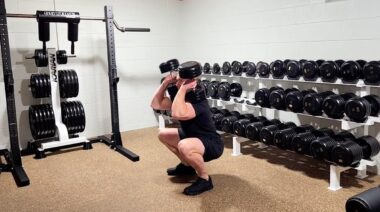I can’t count the number of times I’ve heard people say not to perform back squats because it’s bad for this or that. Usually they say the spine or the knees (or both). And yet it’s one of the most fundamental movements for human beings. In many countries, people rest in a squatting position every single day like a catcher in baseball. Therefore, I’ve always looked on such claims with skepticism.
It’s always good to be prepared with information, though, particularly as a coach. When you work with numerous athletes of every level of ability, you need to be armed to the teeth with knowledge if you want to do any good for your clients. Knee injuries are perhaps the most common of all injuries I see, so it’s important to understand how the squat does affect the knee. Recently a study in the Journal of Strength and Conditioning did just that.
In the study, the researchers focused on pressure at the patellofemoral joint. That’s an anatomical term for where your kneecap rests on your knee. Injuries to this joint account for some 30% of all knee injuries reported, and pressure at this joint seems to have something to do with these injuries.
The researchers looked at various loads and joint angles of the squat exercise and how it affected forces at the knee. Since intensity in exercise science is expressed as a percentage of maximal strength, the researchers noted that maximum strength drops as squat depth increases. For this reason, the researchers tested the athletes’ maxes at all three squat depths they analyzed. They hypothesized that forces at the knee would increase as the squat got deeper, but that reduced maximal weight in the deeper squat would reduce the force evenly.
My own hypothesis was slightly different. I thought the greatest force on the patellofemoral joint would be when the knee was close to a 90 degree angle. That would be the point at which the body is farthest from the center of gravity, meaning it would require higher forces.
Well, we were both wrong. The force at the knee went up with heavier weights and greater squat depth. Even though the rep maxes were less (for some) at the deepest position, the force at the knee was still the highest. However, it should be noted that everyone’s squat form and leverages are different, so these results may not hold true for everyone.
For athletes without injuries, there is some important takeaway to keep in mind. Despite tremendous force at the knee, many people do heavy squats with a lot of depth for years and are just fine. The researchers noted that experienced lifters had reduced knee laxity, meaning the soft tissues of the knee joint were healthier than sedentary controls. So keep working your squat and listen to your body.
For people with existing injury or knee pain, these results also give us something practical to work with. It’s still possible, and in many cases favorable, to strengthen the legs by squatting. However, it’s best to start working on your squat unloaded and above parallel and then slowly increase the depth before adding weight.
References:
1. Joshua Cotter, et. al., “Knee Joint Kinetics in Relation to Commonly Prescribed Squat Loads and Depths,” Journal of Strength and Conditioning Research, 27 (7), 2013.
Photo courtesy of Shutterstock.






